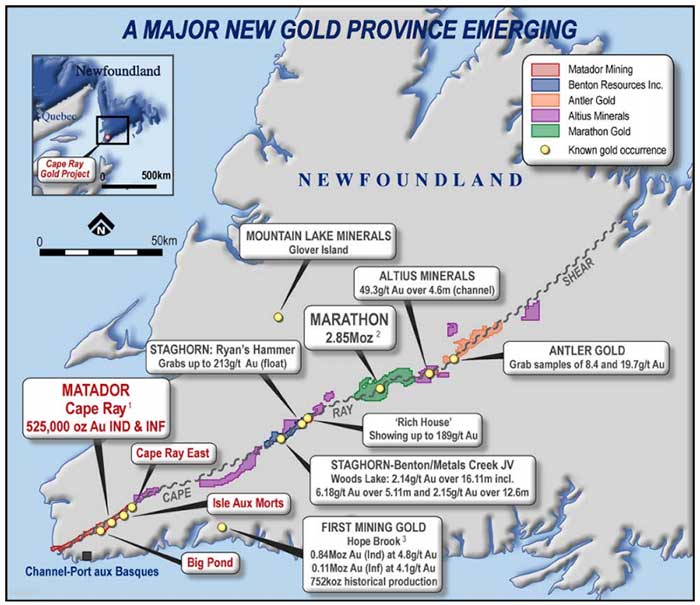Gold explorer Matador Mining stays the course while others fall victim to price pressure

Special report: While some other gold players have succumbed to a recent gold price squeeze, Matador Mining is proving that a good quality project and strong leadership can get you through anything.
Some gold explorers saw their share prices hammered after the price of gold fell below $US1160 per ounce in August, but Matador (ASX:MZZ) has consistently traded at a premium to its 20c IPO price.
The company, which listed in March last year, is trading around 75 per cent above its 35c issue price.
Matador’s goal is to build a multi-million-ounce gold business – led by Paul Criddle, who helped build up Canada’s Roxgold into a $500 million company.
Meanwhile, non-executive director Grant Davey is the man responsible for Matador securing a highly prospective landholding in Newfoundland, Canada.
The Cape Ray gold project (CRGP) is located along the same Cape Ray Shear as the 3.3-million-ounce Valentine Lake mine owned by Marathon Gold and First Mining Gold’s Hope Brook mine, which historically produced 752,000 ounces.
Backing the potential of Matador and its Cape Ray project, EverBlu Capital has placed a “speculative buy” recommendation and a target price of 75c on the company.

Matador has already delivered a resource of 13.4 million tonnes at 1.75 grams per tonne (g/t) for 750,000 ounces over six known gold deposits – and there is “plenty of scope to deliver more”, EverBlu resources analyst Gavin van der Wath said in a recent research report.
The company also uncovered new zones of mineralisation before it even began drilling – which positions it well for a resource update at the completion of the current exploration program.
Drilling is now underway, and Matador has outlined an initial exploration target of 30 million to 36 million tonnes at 1.4g/t to 2.4g/t for 1.3 million to 2.4 million ounces (Moz).
“If delivered this would increase inferred resources at CRGP from 0.75Moz to between 2.0Moz and 3.2Moz over a strike length of around 23km,” Mr van der Wath said.
Mineral resources are categorised in order of increasing geological confidence as inferred, indicated or measured.
“This would translate into a MZZ attributable resource of between 1.6Moz and 2.6Moz with a concomitant increase in valuation!”
Gold will prevail as the ‘safe-haven’
While gold is traditionally the safe-haven investment when geopolitical tensions cause concern, investors have been increasingly flocking to the US dollar following threats of interest rate hikes.
This is what has caused the US dollar gold price to fall.
But investors will return to gold.
Cicero Group founder Matthew Walker told Stockhead earlier this year that “gold has always been the safe-haven investment when things go pear-shaped and will continue to be when the music stops”.
Expert resources analyst Gavin Wendt, meanwhile, says eventually there will be a realisation that gold is oversold.
“Gold will reach a level where it’s clearly undervalued compared to the US dollar,” he told Stockhead recently.
Matching it with the best of them
According to EverBlu, the average value of the ASX gold players is $49 an ounce.
But there is only one other company that has a gold resource on the Cape Ray Shear Zone and that is TSX-listed Marathon Gold.
The implied value of Marathon Gold is $44 an ounce – which Mr van der Wath says compares favourably with the ASX average.
“We believe that the multiple of $44/oz can be applied to value MZZ.”
This would value Matador at $33 million with just a 750,000-ounce resource to start, increasing to between $88 million and $140.8 million depending on how much additional gold the company adds to its resource base.
This values Matador substantially higher than its current market cap of about $17.3 million.
Find the whole research report here
This special report is brought to you by Matador Mining.
This advice has been prepared without taking into account your objectives, financial situation or needs. You should, therefore, consider the appropriateness of the advice, in light of your own objectives, financial situation or needs, before acting on the advice.
If this advice relates to the acquisition, or possible acquisition, of a particular financial product, the recipient should obtain a disclosure document, a Product Disclosure Statement or an offer document (PDS) relating to the product and consider the PDS before making any decision about whether to acquire the product.
UNLOCK INSIGHTS
Discover the untold stories of emerging ASX stocks.
Daily news and expert analysis, it's free to subscribe.
By proceeding, you confirm you understand that we handle personal information in accordance with our Privacy Policy.








